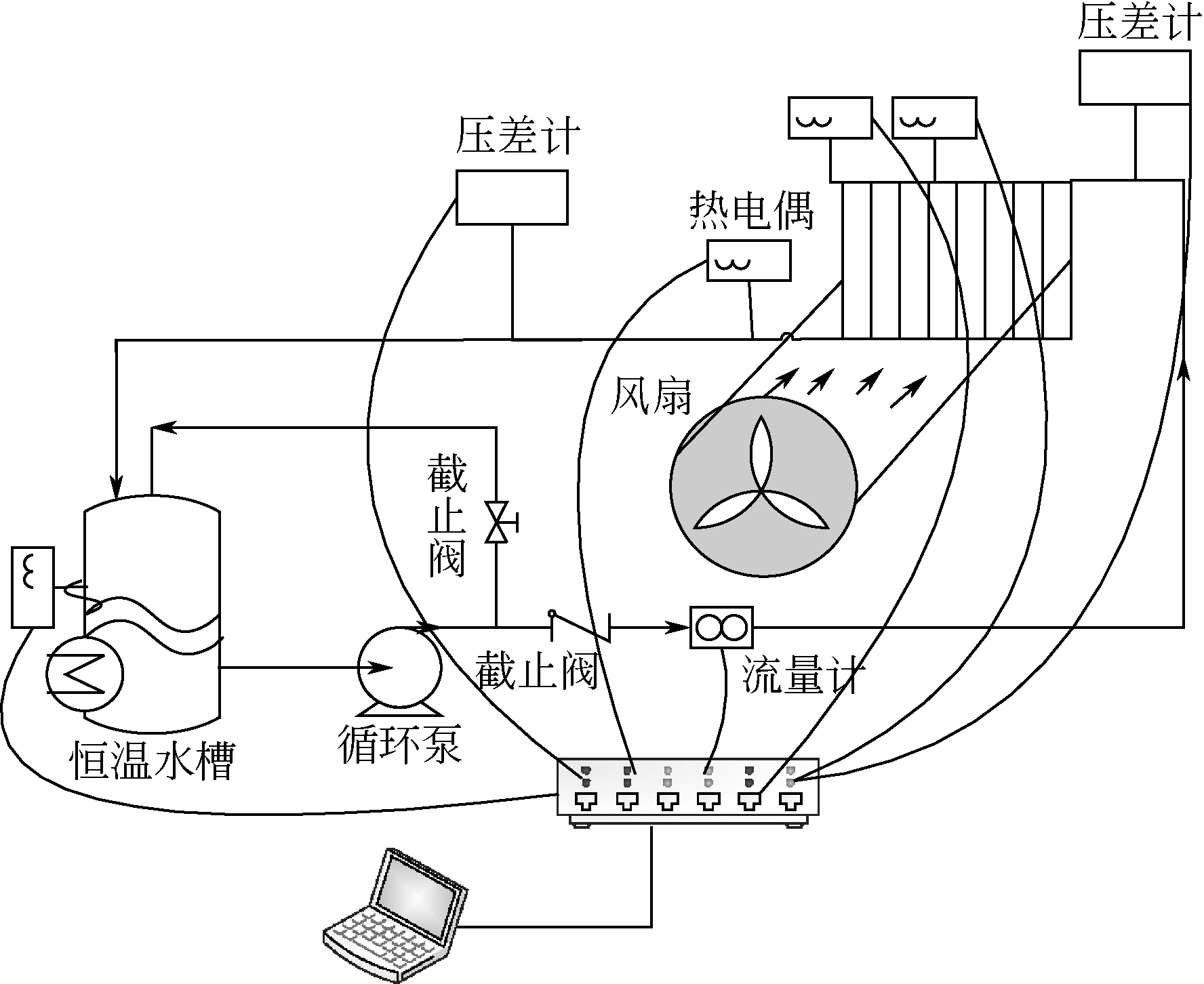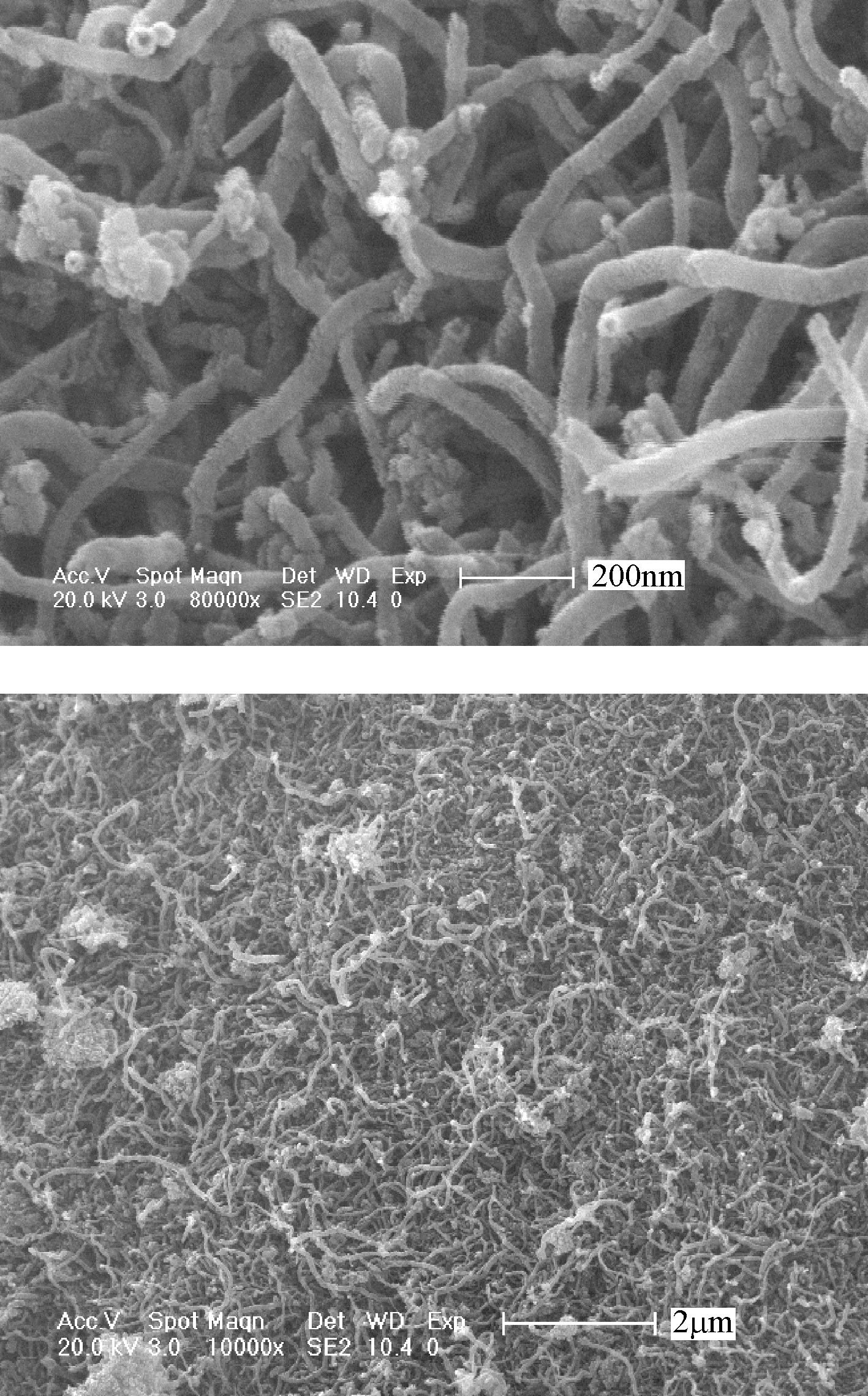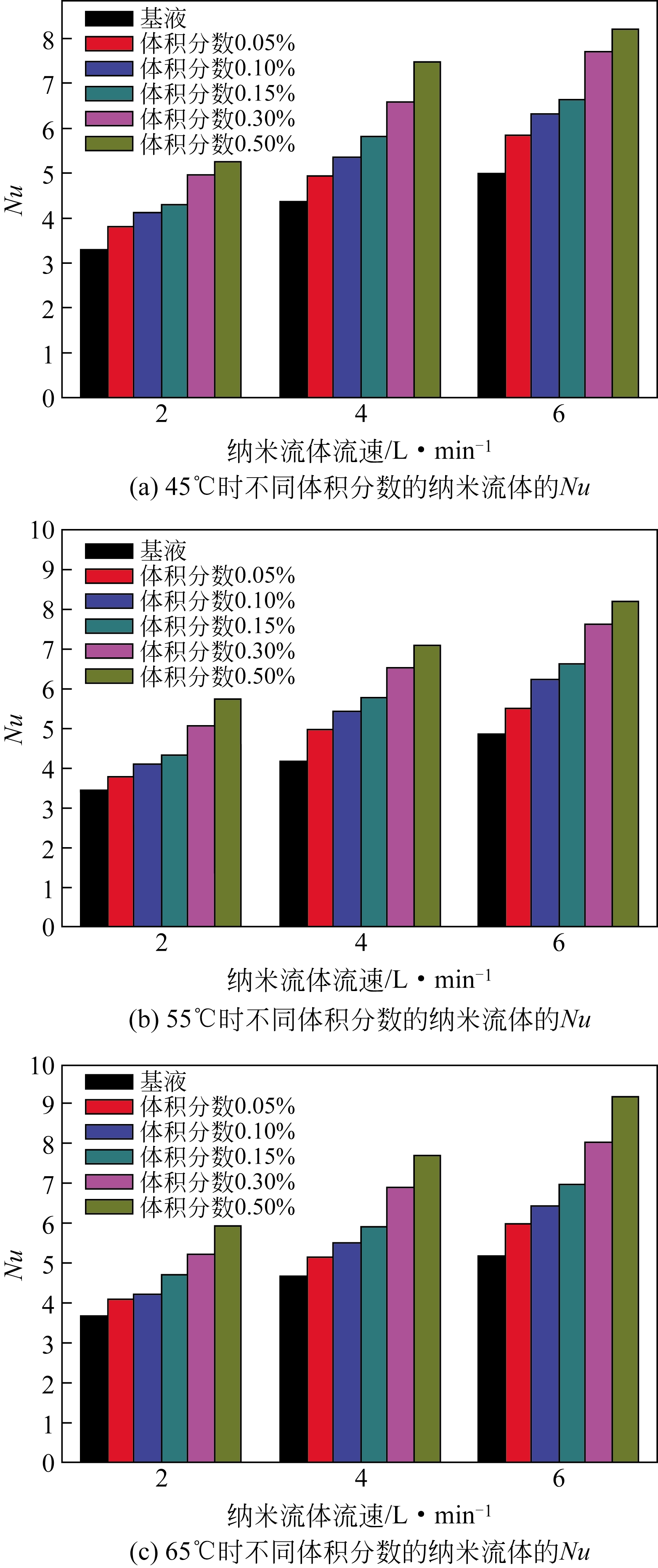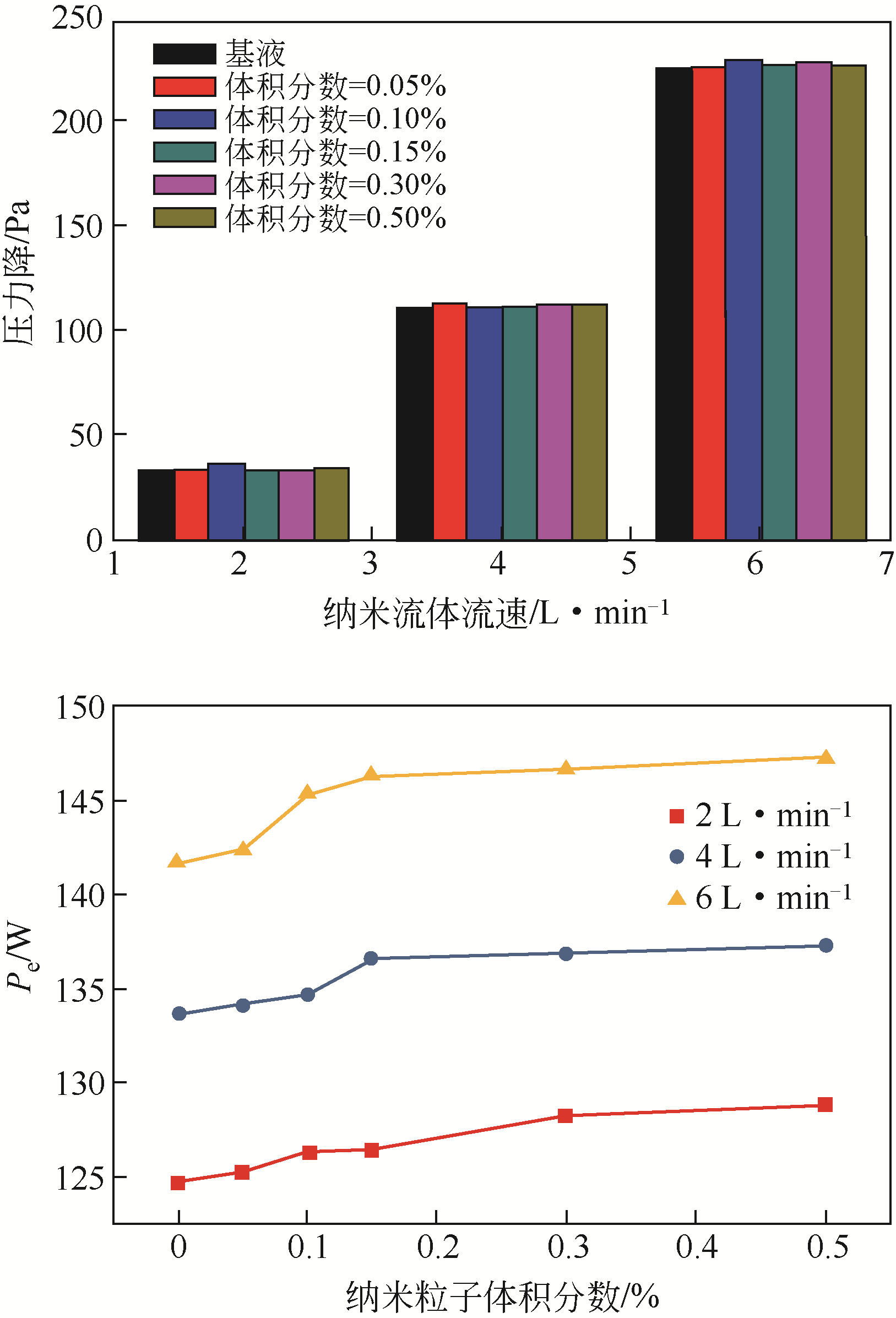化工进展 ›› 2019, Vol. 38 ›› Issue (03): 1207-1217.DOI: 10.16085/j.issn.1000-6613.2018-0999
多壁碳纳米管-水/乙二醇纳米流体在汽车散热器中的传热特性
- 1. 东北电力大学能源与动力工程学院,吉林 吉林 132012
2. 天津大学机械工程学院,中低温热能高效利用教育部重点实验室,天津 300350
-
收稿日期:2018-05-14修回日期:2018-07-21出版日期:2019-03-05发布日期:2019-03-05 -
通讯作者:杨迪 -
作者简介:孙斌 (1972—),男,博士,教授,研究方向为多相流对流传热。E-mail:jlsunbin@126.com 。|杨迪,博士研究生,研究方向为热能工程。E-mail:yangdi@neepu.edu.cn 。 -
基金资助:国家自然科学基金(2020619);吉林省科技发展计划(20160101282JC)
Heat transfer characteristics of MWCNT-water/ethylene glycol nanofluid flow in automotive radiator
Bin SUN1( ),Shuang DONG1,Di YANG1,2(
),Shuang DONG1,Di YANG1,2( ),Hongwei LI1
),Hongwei LI1
- 1. School of Energy and Power Engineering, Northeast Electric Power University, Jilin 132012, Jilin, China
2. Key Laboratory of Efficient Utilization of Low and Medium Grade Energy, MOE, School of Mechanical Engineering, Tianjin University, Tianjin 300350, China
-
Received:2018-05-14Revised:2018-07-21Online:2019-03-05Published:2019-03-05 -
Contact:Di YANG
摘要:
实验研究了多壁碳纳米管(MWCNT)-水/乙二醇纳米流体在汽车散热器中的传热特性。在80%/20%的水/乙二醇基液中制备了5种不同体积分数(0.05%,0.1%,0.15%,0.3%和0.5%)的MWCNT纳米流体,通过研究超声波振荡时间对纳米流体稳定性的影响得出,超声波的振荡时间为1h时,纳米流体的稳定性较为良好。将体积分数为0.15%的纳米流体分别添加十二烷基苯磺酸钠(SDBS)和十六烷基三甲基氯化铵(CTAC)作为分散剂进行稳定性实验,分别采用目测法和透射比法来评价纳米流体的稳定性,选出分散效果较好的分散剂种类和添加量并评价了两种纳米流体的稳定性,结果表明:CTAC的添加量为质量分数0.05%、SDBS的添加量为0.1%时,纳米流体的分散效果较好,并且CTAC的分散效果优于SDBS。分别使用单因素实验设计和正交实验设计对不同浓度的纳米流体在不同流速、温度下的传热特性进行分析,纳米流体的体积流量为2~6L/min,入口温度为45~65℃。结果表明,与基液相比,纳米流体的传热速率有了明显的提高,在本实验的最佳工况下(体积分数0.5%,6L/min,65℃),传热速率可提升35.24%。使用熵值法计算出纳米流体的传热速率、压降和有效泵功的权重分别为0.626、0.035、0.340。基于多指标综合评价方法得出,与纳米流体的传热速率增加相比,纳米流体浓度对压降和有效泵功的不利影响可以忽略不计。
中图分类号:
引用本文
孙斌,董爽,杨迪,李洪伟. 多壁碳纳米管-水/乙二醇纳米流体在汽车散热器中的传热特性[J]. 化工进展, 2019, 38(03): 1207-1217.
Bin SUN,Shuang DONG,Di YANG,Hongwei LI. Heat transfer characteristics of MWCNT-water/ethylene glycol nanofluid flow in automotive radiator[J]. Chemical Industry and Engineering Progress, 2019, 38(03): 1207-1217.
| 名称 | 种类 | 形状 | 大小 | 商家 | 纯度 |
|---|---|---|---|---|---|
| 纳米颗粒 | MWCNT | 管状颗粒 | 20nm | 上海超威纳米科技有限公司 | ≥99.9% |
| 表面分散剂 | CTAC | 白色粉末状固体 | — | 上海双龙化学品厂 | ≥99% |
| SDBS | 白色粉末状固体 | — | 上海双龙化学品厂 | ≥99% |
表1 纳米颗粒和分散剂的特征
| 名称 | 种类 | 形状 | 大小 | 商家 | 纯度 |
|---|---|---|---|---|---|
| 纳米颗粒 | MWCNT | 管状颗粒 | 20nm | 上海超威纳米科技有限公司 | ≥99.9% |
| 表面分散剂 | CTAC | 白色粉末状固体 | — | 上海双龙化学品厂 | ≥99% |
| SDBS | 白色粉末状固体 | — | 上海双龙化学品厂 | ≥99% |
| 种类 | 密度 /kg·m-3 | 比热容 /kJ·kg-1·K-1 | 热导率 /W·m-1·K-1 | 黏度 /mPa·s |
|---|---|---|---|---|
| MWCNT纳米颗粒 | 2100 | 0.71 | 2860 | — |
| 基液(水、乙二醇以80%/20%混合液) | 1026.02 | 3.838 | 0.509 | 1.30 |
表2 MWCTN纳米颗粒和基液在30 ℃时的热物理性质
| 种类 | 密度 /kg·m-3 | 比热容 /kJ·kg-1·K-1 | 热导率 /W·m-1·K-1 | 黏度 /mPa·s |
|---|---|---|---|---|
| MWCNT纳米颗粒 | 2100 | 0.71 | 2860 | — |
| 基液(水、乙二醇以80%/20%混合液) | 1026.02 | 3.838 | 0.509 | 1.30 |
| 编号 | λ/nm | 编号 | λ/nm |
|---|---|---|---|
| 1 | 235 | 5 | 242 |
| 2 | 242 | 6 | 240 |
| 3 | 238 | 平均 | 240 |
| 4 | 243 |
表3 最佳吸收波长重复实验结果
| 编号 | λ/nm | 编号 | λ/nm |
|---|---|---|---|
| 1 | 235 | 5 | 242 |
| 2 | 242 | 6 | 240 |
| 3 | 238 | 平均 | 240 |
| 4 | 243 |
| 测量参数(仪器设备) | 精度 |
|---|---|
| 温度(热电偶) | 0℃时精度±0.15K,100℃时精度±0.35K |
| 流速(流量计) | 1.0% |
| 压降(罗斯蒙特压差计) | 0.5% |
| 有效泵功(功率计) | 0.5% |
| 数据采集器 | 1.0% |
表4 实验中的测量参数和最大测量误差
| 测量参数(仪器设备) | 精度 |
|---|---|
| 温度(热电偶) | 0℃时精度±0.15K,100℃时精度±0.35K |
| 流速(流量计) | 1.0% |
| 压降(罗斯蒙特压差计) | 0.5% |
| 有效泵功(功率计) | 0.5% |
| 数据采集器 | 1.0% |
| 体积分数/% | 热导率增加率/% | 对流传热系数增加率/% |
|---|---|---|
| 0.05 | 0.15 | 5.64 |
| 0.1 | 0.30 | 8.53 |
| 0.15 | 0.45 | 10.13 |
| 0.3 | 0.90 | 17.14 |
| 0.5 | 1.51 | 20.33 |
表5 纳米流体的热导率和对流传热系数的增加对比
| 体积分数/% | 热导率增加率/% | 对流传热系数增加率/% |
|---|---|---|
| 0.05 | 0.15 | 5.64 |
| 0.1 | 0.30 | 8.53 |
| 0.15 | 0.45 | 10.13 |
| 0.3 | 0.90 | 17.14 |
| 0.5 | 1.51 | 20.33 |
| 测试号码 | A体积分数 | B入口温度 | C纳米流体流速 | 对流传热系数隶属度 | 压降隶属度 | 有效泵功隶属度 | 综合评分 |
|---|---|---|---|---|---|---|---|
| 1 | 1(0.15%) | 1(45℃) | 1(2L·min?1) | 0 | 0 | 0.0006 | 0.0003 |
| 2 | 1 | 2(55℃) | 3(6L·min?1) | 0.4612 | 0.9898 | 0.9908 | 0.9722 |
| 3 | 1 | 3(65℃) | 2(4L·min?1) | 0.3268 | 0.4008 | 0.2907 | 0.3293 |
| 4 | 2(0.3%) | 1 | 3 | 0.6886 | 0.9942 | 0.9948 | 0.9839 |
| 5 | 2 | 2 | 2 | 0.4507 | 0.4029 | 0.2920 | 0.3351 |
| 6 | 2 | 3 | 1 | 0.1907 | 0.0006 | 0 | 0.0068 |
| 7 | 3(0.5%) | 1 | 2 | 0.6516 | 0.4058 | 0.2937 | 0.3441 |
| 8 | 3 | 2 | 1 | 0.2965 | 0.0015 | 0.0003 | 0.0109 |
| 9 | 3 | 3 | 3 | 1 | 1 | 1 | 1 |
| K 1 | 1.3018 | 1.3283 | 0.018 | ||||
| K 2 | 1.3258 | 1.3182 | 1.0085 | ||||
| K 3 | 1.3550 | 1.3361 | 2.9561 | ||||
| 极差 | 0.0532 | 0.0179 | 2.9381 | ||||
| 主要因素和次要因素排序 | CAB | ||||||
| 最佳方案 | C 3 A 3 B 3 | ||||||
表6 正交实验结果
| 测试号码 | A体积分数 | B入口温度 | C纳米流体流速 | 对流传热系数隶属度 | 压降隶属度 | 有效泵功隶属度 | 综合评分 |
|---|---|---|---|---|---|---|---|
| 1 | 1(0.15%) | 1(45℃) | 1(2L·min?1) | 0 | 0 | 0.0006 | 0.0003 |
| 2 | 1 | 2(55℃) | 3(6L·min?1) | 0.4612 | 0.9898 | 0.9908 | 0.9722 |
| 3 | 1 | 3(65℃) | 2(4L·min?1) | 0.3268 | 0.4008 | 0.2907 | 0.3293 |
| 4 | 2(0.3%) | 1 | 3 | 0.6886 | 0.9942 | 0.9948 | 0.9839 |
| 5 | 2 | 2 | 2 | 0.4507 | 0.4029 | 0.2920 | 0.3351 |
| 6 | 2 | 3 | 1 | 0.1907 | 0.0006 | 0 | 0.0068 |
| 7 | 3(0.5%) | 1 | 2 | 0.6516 | 0.4058 | 0.2937 | 0.3441 |
| 8 | 3 | 2 | 1 | 0.2965 | 0.0015 | 0.0003 | 0.0109 |
| 9 | 3 | 3 | 3 | 1 | 1 | 1 | 1 |
| K 1 | 1.3018 | 1.3283 | 0.018 | ||||
| K 2 | 1.3258 | 1.3182 | 1.0085 | ||||
| K 3 | 1.3550 | 1.3361 | 2.9561 | ||||
| 极差 | 0.0532 | 0.0179 | 2.9381 | ||||
| 主要因素和次要因素排序 | CAB | ||||||
| 最佳方案 | C 3 A 3 B 3 | ||||||
| A | —— | 面积, m2 |
| A s | —— | 散热管面积, m2 |
| CS | —— | 综合评分 |
| cp | —— | 定压比热容, kJ/(kg·K) |
| D | —— | 管外径, mm |
| D h | —— | 当量直径, mm |
| d | —— | 管边缘小径, mm |
| h | —— | 对流传热系数, W/(m2·K) |
| k | —— | 热导率, W/(m·K) |
| L | —— | 管长, mm |
| M | —— | 决策矩阵 |
| m | —— | 质量流量, kg/s |
| mp | —— | 隶属度 |
| Nu | —— | Nusselt数 |
| Q | —— | 传热速率, W |
| sm | —— | 测试号码 |
| T b | —— | 特征温度, K |
| T in | —— | 进口温度, K |
| T out | —— | 出口温度, K |
| T s | —— | 管壁温度, K |
| val | —— | 测量值 |
| ws | —— | 权重 |
| Y | —— | 贡献矩阵 |
| ρ | —— | 密度, kg/m3 |
| φ | —— | 体积分数 |
| ? | —— | 形状因子 |
| ψ | —— | 颗粒表面球形度 |
| 下角标 | ||
| bf | —— | 基液 |
| in | —— | 进口 |
| nf | —— | 纳米流体 |
| out | —— | 出口 |
| p | —— | 纳米颗粒 |
符号说明
| A | —— | 面积, m2 |
| A s | —— | 散热管面积, m2 |
| CS | —— | 综合评分 |
| cp | —— | 定压比热容, kJ/(kg·K) |
| D | —— | 管外径, mm |
| D h | —— | 当量直径, mm |
| d | —— | 管边缘小径, mm |
| h | —— | 对流传热系数, W/(m2·K) |
| k | —— | 热导率, W/(m·K) |
| L | —— | 管长, mm |
| M | —— | 决策矩阵 |
| m | —— | 质量流量, kg/s |
| mp | —— | 隶属度 |
| Nu | —— | Nusselt数 |
| Q | —— | 传热速率, W |
| sm | —— | 测试号码 |
| T b | —— | 特征温度, K |
| T in | —— | 进口温度, K |
| T out | —— | 出口温度, K |
| T s | —— | 管壁温度, K |
| val | —— | 测量值 |
| ws | —— | 权重 |
| Y | —— | 贡献矩阵 |
| ρ | —— | 密度, kg/m3 |
| φ | —— | 体积分数 |
| ? | —— | 形状因子 |
| ψ | —— | 颗粒表面球形度 |
| 下角标 | ||
| bf | —— | 基液 |
| in | —— | 进口 |
| nf | —— | 纳米流体 |
| out | —— | 出口 |
| p | —— | 纳米颗粒 |
| 1 | 中商产业研究院. 2016年全球汽车销量大数据 :中国汽车销量蝉联第一[EB/OL]. . |
| In the commercial and industrial research institute. Global car sales data for 2016: car sales in China for more than the first[EB/OL]. http: // . | |
| 2 | 韩松 . 车用发动机智能冷却系统基础问题研究[D]. 杭州:浙江大学, 2012. |
| HAN Song . Fundamental vesearch on intelligent cooling system for vehicle engines[D]. Hangzhou: Zhejiang University, 2012. | |
| 3 | CHO H, JUNG D , FILIPI Z S , et al . Application of controllable electric coolant pump for fuel economy and cooling performance improvement [J]. Journal of Engineering for Gas Turbines & Power, 2007, 129(1): 43-50. |
| 4 | PANG H H , BRACE C J , AKEHURST S . Potential of a controllable engine cooling system to reduce NO x emissions in diesel engines [C]// SAE World Congress & Exhibition. SAE Technical Papers. New York: SAE International, 2004: 146-160. |
| 5 | BERNHARD U , FRIEDRICH B , JÜRGEN F , et al . Development of engine cooling systems by coupling CFD simulation and heat exchanger analysis programs [C]//International Congress and Exposition. SAE Technical Papers. New York: SAE International, 2001: 23-37. |
| 6 | KULKARNI D P , VAJJHA R S , DAS D K, et al . Application of aluminum oxide nanofluids in diesel electric generator as jacket water coolant [J]. Applied Thermal Engineering, 2008, 28(14): 1774-1781. |
| 7 | LEE S P, CHOI S , LI S , et al . Measuring thermal conductivity of fluids containing oxide nanoparticles [J]. ASME Journal of Heat Transfer, 1999, 121(2): 280-289. |
| 8 | NARAKI M , PEYGHAMBARZADEH S M , HASHEMABADI S H , et al . Parametric study of overall heat transfer coefficient of CuO/water nanofluids in a car radiator[J]. International Journal of Thermal Sciences, 2013, 66: 82-90. |
| 9 | HUSSEIN A M , BAKAR R A , KADIRGAMA K , et al . Heat transfer enhancement using nanofluids in an automotive cooling system[J]. International Communications in Heat & Mass Transfer, 2014, 53(4): 195-202. |
| 10 | M'HAMED B , SIDIK N A C , AKHBAR M F A , et al . Experimental study on thermal performance of MWCNT nanocoolant in Perodua Kelisa, 1000 cc radiator system[J]. International Communications in Heat & Mass Transfer, 2016, 76(8): 156-161. |
| 11 | OLIVEIRA G A , CONTRERAS E M C , FILHO E P B . Experimental study on the heat transfer of MWCNT/water nanofluid flowing in a car radiator [J]. Applied Thermal Engineering, 2016, 111(1): 1450-1456. |
| 12 | ALI M, EL-LEATHY A M , AL-SOFYANY Z . The effect of nanofluid concentration on the cooling system of vehicles radiator[J]. Advances in Mechanical Engineering, 2014, 96(8): 1-13. |
| 13 | CHAKRABORTY S , SARKAR I , BEHERA D K , et al . Experimental investigation on the effect of dispersant addition on thermal and rheological characteristics of TiO2 nanofluid[J]. Powder Technology, 2017, 307(2): 10-24. |
| 14 | DAS P K, MALLIK A K , GANGULY R , et al . Synthesis and characterization of TiO2-water nanofluids with different surfactants[J]. International Communications in Heat & Mass Transfer, 2016, 75(7): 341-348. |
| 15 | 王宏宇,王助良,杜敏,等 . 纳米流体的制备及稳定性分析[J]. 河南科技大学学报(自然科学版), 2016,53(1): 5-8, 25. |
| WANG H Y , WANG Z L , DU M , et al . Preparation and stability of nanofluids[J]. Journal of Henan University of Science and Technology (Natural Science), 2016, 53(1): 5-8, 25. | |
| 16 | LÜ Y Z , LI C , SUN Q , et al . Effect of dispersion method on stability and dielectric strength of transformer oil-based TiO2 nanofluids[J]. Nanoscale Research Letters, 2016, 11(1): 515-524. |
| 17 | PAK B C, CHO Y I . Hydrodynamic and heat transfer study of dispersed fluids with submicron metallic oxide particles[J]. Experimental Heat Transfer, 1998, 11(2): 151-170. |
| 18 | ŻYŁA G . Thermophysical properties of ethylene glycol based yttrium aluminum garnet (Y3Al5O12-EG) nanofluids[J]. International Journal of Heat & Mass Transfer, 2016, 92(1): 751-756. |
| 19 | XUAN Yimin , ROETZEL W . Conceptions for heat transfer correlation of nanofluids[J]. International Journal of Heat & Mass Transfer, 2000, 43(19): 3701-3707. |
| 20 | CHEN Haisheng , WITHARANA S , JIN Yi , et al . Predicting thermal conductivity of liquid suspensions of nanoparticles (nanofluids) based on rheology [J]. Particuology, 2009, 7(2): 151-157. |
| 21 | BEJAN A . Convection heat transfer[J]. Wiley, 2013, 17(1): 153-232. |
| 22 | 郭显光 . 熵值法及其在综合评价中的应用[J]. 财贸研究, 1994(6):56-60. |
| GUO X G . Entropy method and its application in comprehensive evaluation[J]. Finance and Trade Research, 1994(6): 56-60. | |
| 23 | MOFFAT R J . Describing the uncertainties in experimental results [J]. Experimental Thermal & Fluid Science, 1988, 1(1): 3-17. |
| 24 | XUAN Yimin , LI Qiang . Investigation on convective heat transfer and flow features of nanofluids[J]. Journal of Heat Transfer, 2003, 125(1): 151-155. |
| 25 | KAKAÇ S , PRAMUANJAROENKIJ A . Review of convective heat transfer enhancement with nanofluids[J]. International Journal of Heat & Mass Transfer, 2009, 52(13/14): 3187-3196. |
| 26 | WANG Xinwei , XU Xianfan , CHOI S U S . Thermal conductivity of nanoparticle-fluid mixture[J]. Journal of Thermophysics & Heat Transfer, 1999, 13(13): 474-480. |
| 27 | KEBLINSKI P , PHILLPOT S R , CHOI S U S , et al . Mechanisms of heat flow in suspensions of nano-sized particles (nanofluids) [J]. International Journal of Heat & Mass Transfer, 2002, 45(4): 855-863. |
| 28 | BUONGIORNO J . Convective transport in nanofluids [J]. Journal of Heat Transfer, 2006, 128(3): 240-250. |
| [1] | 张岱凌, 丁玉梅, 左夏华, 黎昊为, 杨卫民, 阎华, 安瑛. 废弃墨粉纳米流体的光热特性[J]. 化工进展, 2023, 42(9): 4791-4798. |
| [2] | 王鑫, 王兵兵, 杨威, 徐志明. 金属表面PDA/PTFE超疏水涂层抑垢与耐腐蚀性能[J]. 化工进展, 2023, 42(8): 4315-4321. |
| [3] | 娄宝辉, 吴贤豪, 张驰, 陈臻, 冯向东. 纳米流体用于二氧化碳吸收分离研究进展[J]. 化工进展, 2023, 42(7): 3802-3815. |
| [4] | 陆洋, 周劲松, 周启昕, 王瑭, 刘壮, 李博昊, 周灵涛. CeO2/TiO2吸附剂煤气脱汞产物的浸出规律[J]. 化工进展, 2023, 42(7): 3875-3883. |
| [5] | 吴展华, 盛敏. 绝热加速量热仪在反应安全风险评估应用中的常见问题[J]. 化工进展, 2023, 42(7): 3374-3382. |
| [6] | 谢志伟, 吴张永, 朱启晨, 蒋佳骏, 梁天祥, 刘振阳. 植物油基Ni0.5Zn0.5Fe2O4磁流体的黏度特性及磁黏特性[J]. 化工进展, 2023, 42(7): 3623-3633. |
| [7] | 杨竞莹, 施万胜, 黄振兴, 谢利娟, 赵明星, 阮文权. 改性纳米零价铁材料制备的研究进展[J]. 化工进展, 2023, 42(6): 2975-2986. |
| [8] | 杨扬, 孙志高, 李翠敏, 李娟, 黄海峰. 静态条件下表面活性剂OP-13促进HCFC-141b水合物生成[J]. 化工进展, 2023, 42(6): 2854-2859. |
| [9] | 郭文杰, 翟玉玲, 陈文哲, 申鑫, 邢明. Al2O3-CuO/水混合纳米流体对流传热性能及热经济性分析[J]. 化工进展, 2023, 42(5): 2315-2324. |
| [10] | 李玲, 马超峰, 卢春山, 于万金, 石能富, 金佳敏, 张建君, 刘武灿, 李小年. 新型含氟替代品1,1,2-三氟乙烯的合成工艺与催化剂研究进展[J]. 化工进展, 2023, 42(4): 1822-1831. |
| [11] | 殷铭, 郭晋, 庞纪峰, 吴鹏飞, 郑明远. 铜催化剂在涉氢反应中的失活机制和稳定策略[J]. 化工进展, 2023, 42(4): 1860-1868. |
| [12] | 李云闯, 谢方明, 席亚男, 万新月, 孙玉虎, 赵永峰, 李根, 刘宏海, 高雄厚, 刘洪涛. 高水热稳定性介孔分子筛的低成本合成研究进展[J]. 化工进展, 2023, 42(4): 1877-1884. |
| [13] | 王钰琢, 李刚. 硫、氮共掺杂三维石墨烯的全固态超级电容器[J]. 化工进展, 2023, 42(4): 1974-1982. |
| [14] | 谭德新, 曾佳欣, 梁莉敏, 申思慧, 曾子倩, 王艳丽. 取代烷基变化对芳炔单体及其聚合物性能影响[J]. 化工进展, 2023, 42(4): 2031-2037. |
| [15] | 宗悦, 张瑞君, 高珊珊, 田家宇. “特殊稳定型”压力驱动薄膜复合(TFC)脱盐膜的研究进展[J]. 化工进展, 2023, 42(4): 2058-2067. |
| 阅读次数 | ||||||
|
全文 |
|
|||||
|
摘要 |
|
|||||












